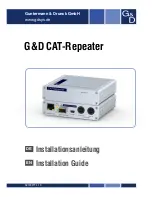
P/N 474131
Rev. D 27-06-11
24
8.
Vent Termination – Horizontal (Continued)
The terminal must be located (See
Figure 17
):
• at least 3.3M (10 ft) from any opening into a building
• at least 0.3 M (12 in) above finished grade or the
normally expected snow accumulation level,
whichever is higher
• at least 1.2 M (4 ft) horizontally from electric
meters, gas meters, regulators and relief equipment
• at least 2.1 M (7 ft) above grade adjacent to
walkways or similar traffic areas
Allow at least 1 M (3 ft) vertical clearance over vent
termination when terminating under an overhang or
deck.
Avoid corners or alcoves where snow or wind could
have an effect. Exhaust may affect shrubbery and some
building materials. Keep shrubbery away from
termination. To prevent staining or deterioration, sealing
or shielding exposed surfaces may be required.
WARNING
Section 3. Installation
3" (7.6 cm) Min.,
12" (30.5 cm) Max.
Clearance
Condensate
drain w/Trap
Condensate
Tee
Support
weight
of pipe
Approved
T
Termina
l
Metal Special
Gas Vent
requires
Appliance
Adapter
Metal
Vent
Body
Slope at least
1/4" per foot
(2 cm per Meter)
down towards
condensate drain
(Optional)
Figure 18.
HORIZONTAL OR VERTICAL VENTING FLEXIBLE DUCT (FLEX-VENT)
(
See Figures 15, 16, 17 & 19)
NOTE: THE ALLOWABLE VENT RUNS FOR EACH VENT
PIPE DIAMETER ARE DIFFERENT AND CAN NOT BE
EXCEEDED.
It is recommended that vent runs over 5.4 m (18 ft) may need to be
insulated to reduce condensation related problems and/or the use of
a condensate trap in the vent run close to the heater may be
necessary in certain installations such as cold climates. Horizontal
vents 1 m (3 feet) or less in length do not require a condensate tee.
The MasterTemp heater is suitable for through-the-wall venting. See
Table 8 for maximum permissible Flexible Vent lengths.
CAUTION
Do
NOT
combine exhaust vent pipes to a common exhaust vent in
multiple unit installations. Run separate vent pipes.
t
n
e
V
-
x
e
l
F
)
.
n
i
6
(
m
m
0
5
1
)
l
a
t
n
o
z
i
r
o
H
r
o
l
a
c
i
t
r
e
V
(
*
°
0
9
f
o
.
o
N
d
n
e
B
s
n
i
h
t
g
n
e
L
m
u
m
i
x
a
M
)
M
(
t
e
e
F
0
)
.
t
f
8
3
(
m
6
.
1
1
1
)
.
t
f
6
2
(
m
8
*
n
i
r
o
)
.
t
f
1
(
M
4
3
.
0
s
i
h
t
g
n
e
l
t
n
e
v
m
u
m
i
n
i
M
,
n
o
i
t
c
u
r
t
s
n
i
s
’
r
e
r
u
t
c
a
f
u
n
a
m
t
n
e
v
h
t
i
w
e
c
n
a
d
r
o
c
c
a
s
t
n
e
v
l
a
t
n
o
z
i
r
o
H
.
s
e
d
o
c
l
a
n
o
i
t
a
n
d
n
a
l
a
c
o
l
d
n
a
a
e
r
i
u
q
e
r
t
o
n
o
d
h
t
g
n
e
l
n
i
s
s
e
l
r
o
)
n
i
3
(
m
1
e
h
t
d
r
a
w
o
t
n
w
o
d
e
p
o
l
s
t
s
u
m
t
u
b
,
e
e
t
e
t
a
s
n
e
d
n
o
c
w
o
ll
a
o
t
)
.
t
f
/
n
i
4
/
1
(
r
e
t
e
m
e
h
t
o
t
m
c
2
t
a
t
e
l
t
u
o
.
n
i
a
r
d
o
t
e
t
a
s
n
e
d
n
o
c
s
a
)
n
i
3
3
.
4
(
m
m
0
1
1
e
b
o
t
m
u
m
i
n
i
m
s
u
i
d
a
R
*
*
.
9
1
e
r
u
g
i
F
n
i
n
w
o
h
s
Fire Hazard.
Do not run the heater vent into a common vent with any other appliance. Do not run the Special Gas Vent into,
through, or within any active vent such as a factory built or masonry chimney.
Table 8.
Flexible Vent
Section
Figure 19.
110 mm (4.33 in)
Radius Minimum
MINIMUM FLEX BEND RADIUS
NOTE: After installation, installer must check for correct and safe operation of the heater.
















































